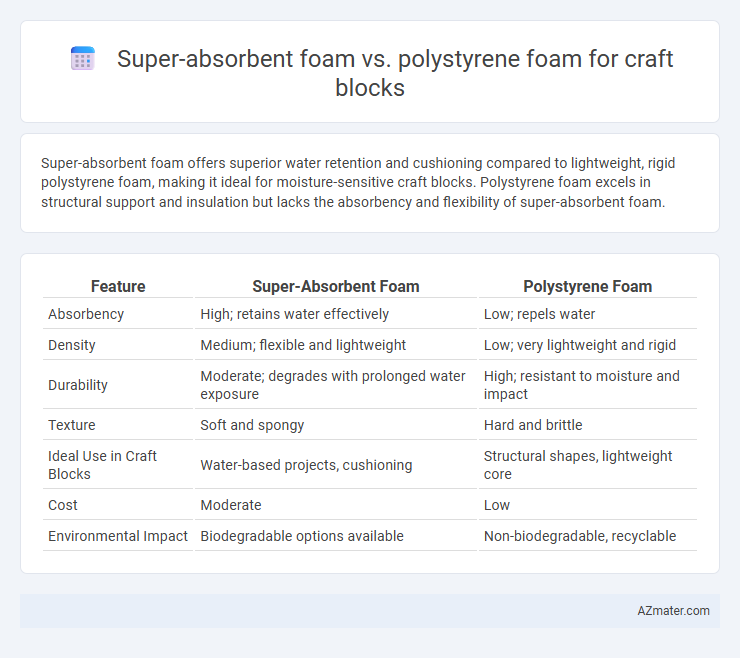Super-absorbent foam offers superior water retention and cushioning compared to lightweight, rigid polystyrene foam, making it ideal for moisture-sensitive craft blocks. Polystyrene foam excels in structural support and insulation but lacks the absorbency and flexibility of super-absorbent foam.
Table of Comparison
| Feature | Super-Absorbent Foam | Polystyrene Foam |
|---|---|---|
| Absorbency | High; retains water effectively | Low; repels water |
| Density | Medium; flexible and lightweight | Low; very lightweight and rigid |
| Durability | Moderate; degrades with prolonged water exposure | High; resistant to moisture and impact |
| Texture | Soft and spongy | Hard and brittle |
| Ideal Use in Craft Blocks | Water-based projects, cushioning | Structural shapes, lightweight core |
| Cost | Moderate | Low |
| Environmental Impact | Biodegradable options available | Non-biodegradable, recyclable |
Introduction to Foam Types in Crafting
Super-absorbent foam, known for its high moisture retention and flexibility, offers enhanced cushioning and water absorption in craft blocks compared to traditional polystyrene foam. Polystyrene foam, characterized by its lightweight structure and rigidity, provides excellent durability and shape retention but lacks absorbency. Choosing between these foam types depends on the desired balance of absorbency and structural support in crafting projects.
What is Super-Absorbent Foam?
Super-absorbent foam is a highly porous material engineered to absorb and retain large volumes of liquid relative to its weight, making it ideal for moisture control in craft blocks. Unlike polystyrene foam, which is primarily lightweight and rigid, super-absorbent foam is designed to trap water, enhancing durability and reducing shrinkage in craft applications. Its unique polymer structure enables efficient water management, resulting in improved texture and longevity for moisture-sensitive craft projects.
Key Features of Polystyrene Foam
Polystyrene foam, widely used in craft blocks, is characterized by its lightweight structure, excellent thermal insulation, and high rigidity, making it ideal for detailed modeling and structural support. Its resistance to moisture and chemicals enhances durability, while easy-to-cut properties allow precision shaping for various craft applications. Compared to super-absorbent foam, polystyrene offers superior stability and strength, essential for long-lasting creative projects.
Absorption Capabilities: Side by Side
Super-absorbent foam exhibits superior absorption capabilities compared to polystyrene foam, with the ability to retain up to 300 times its weight in water due to its cross-linked polymer structure. Polystyrene foam, predominantly composed of expanded beads, has minimal water absorption, which limits its effectiveness in moisture retention applications. This makes super-absorbent foam significantly more suitable for craft blocks requiring high water retention and moisture management.
Durability and Strength Comparison
Super-absorbent foam demonstrates superior durability in craft block applications due to its resistance to wear and tear under repeated use, maintaining structural integrity better than polystyrene foam. Polystyrene foam, while lightweight and cost-effective, tends to be more brittle and prone to crumbling or breaking under pressure. Strength tests reveal that super-absorbent foam supports heavier loads and better withstands impacts, making it preferable for long-lasting craft projects.
Crafting Flexibility and Cutability
Super-absorbent foam offers superior crafting flexibility due to its pliable structure, allowing intricate shapes and detailed cuts without crumbling. Polystyrene foam, while lightweight and rigid, tends to crack or chip when cut into complex forms, limiting precision in crafting projects. The enhanced cutability of super-absorbent foam makes it ideal for artists seeking smooth edges and fine details in craft blocks.
Environmental Impact of Both Foams
Super-absorbent foam offers biodegradability and lower environmental toxicity compared to polystyrene foam, which is non-biodegradable and contributes significantly to landfill waste and marine pollution. Polystyrene foam production relies heavily on petroleum, releasing higher greenhouse gas emissions, whereas super-absorbent foam often utilizes more sustainable raw materials with reduced carbon footprints. Disposal of super-absorbent foam poses less risk to ecosystems due to its ability to break down naturally, in contrast to polystyrene foam's persistence and contribution to microplastic contamination.
Cost Analysis: Super-Absorbent vs Polystyrene
Super-absorbent foam for craft blocks typically costs 15-25% more than polystyrene foam due to advanced materials and manufacturing processes. Polystyrene foam remains a budget-friendly option with widespread availability and lower production expenses. Evaluating long-term durability and performance can justify the initial price difference when selecting between these foam types.
Best Use Cases for Each Foam Type
Super-absorbent foam excels in craft blocks requiring moisture retention and cushioning, making it ideal for floral foam arrangements, water-sensitive projects, and impact absorption in DIY crafts. Polystyrene foam is preferred for lightweight, rigid structures such as model building, insulation, and decorative blocks due to its durability and ease of shaping. Choosing between the two depends on whether moisture management or structural rigidity is the primary craft block requirement.
Conclusion: Choosing the Right Craft Block
Super-absorbent foam offers superior moisture retention and cushioning properties, making it ideal for craft blocks that require durability and water resistance. Polystyrene foam provides lightweight structure and cost-effectiveness but lacks the absorbency and durability of super-absorbent variants. Selecting the right craft block depends on the project's needs for moisture control, structural support, and budget constraints.

Infographic: Super-absorbent foam vs Polystyrene foam for Craft block
 azmater.com
azmater.com